



© David Hallam - 2008 - 2025

|
Individual Inns & Pubs in Beeston - R-S
This page is still under construction
We hope to have completed shortly
Details of Individual Beeston Pubs: B - C
D - J
M - Q
R - S
T - W
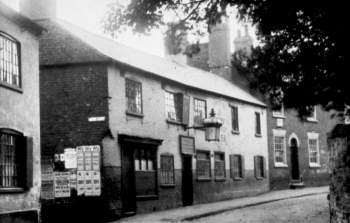 The Rose Inn - The Rose Inn once stood on Middle Street (then Market Street) and almost opposite the southern end of Chapel Steet, on the western corner
of Moore Gate. It was opened in the latter years of the 1850s, as a beer house, by Thomas Dore, to serve a then relatively thriving demand in that area of Beeston, despite existing
competition from The White Lion.
The Rose Inn - The Rose Inn once stood on Middle Street (then Market Street) and almost opposite the southern end of Chapel Steet, on the western corner
of Moore Gate. It was opened in the latter years of the 1850s, as a beer house, by Thomas Dore, to serve a then relatively thriving demand in that area of Beeston, despite existing
competition from The White Lion.
Thomas Dore was born in Nottingham in about 1823, one of over fifteen children born to Thomas Dore (c1792 to 1857) and his wife Ann (née Rogers), having married in 1814 at
Wollaton, where Ann had been born. Although there is some evidence that Thomas senior had been born in Beeston, he and his wife were to live most of their married life in Nottingham
taking whatever work he could, and it was there that he was to end his life, following his wife's death, in the workhouse there.
Thomas junior, the main subject of this account, married Ann Pidgeon who had been born in Leicester in 1825, the daughter of John Pidgeon, a bleacher. Both he and his elder brother
William had been able to establish themselves as bakers and, by 1851, he was trading on Independant Hill in Nottingham with the help of his wife, while William was also trading as a
baker on Glasshouse Street, Nottingham, again supported by his wife Ann (née Harrison).
But, as we have seen, within the next ten years, Thomas had decided to diversify his business interests into the licenced trade and had chosen Beeston where he must have thought there
was enough customers to support another pub, perhaps a brave conclusion given that Beeston's population had, for the time being, plateaued at just over 3000 which meant that there was less
than 250 men, women and children for each of the then thirteen licenced premises! But somehow it appears to have worked - perhaps it was the location, formed as it was, apparently from existing buildings
in an area which perhaps appealed to its largely working-class customers. And, this apparent success was despite the nearby competition from the well established White Lion which was just a short
distance away. Thats not to say that Thomas depended entirely on The Rose. In fact, he had not abandoned his involvement in the Nottingham bakery business and was to regularly drive there
with his own pony and cart, upwards of three times each week to oversee his business there. Sometimes he took a cab that he owned. And too, he had diversified his Beeston interests by acquiring
a piece of land, extending to some 12 acres, on Middle Street, east of Brown Lane (now Station Road), known as Rickett's Fields, probably situated around what is now Wood Street.
By 1865, it appears that he had put The Rose behind him - and, as we will see, it was to struggle with a succession of short-term, mainly inexperienced landlords over the next 30 years or more,
some of which, we can find no other record. For his part Dore had become the landlord of The Rising Sun which he appears to have had built on his Middle Street site, a venture which was to
be short lived as, in September 1869 a licence for the house was refused at the Nottinghamshire Brewster Sessions. This was to mark the end of The Rising Sun which then became widly known as 'the pub that
never was' - although, as we have seen, Dore had operated it for a short while.
Thomas was to live out his life farming his land in Beeston. He died there in June 1885 and was buried in Beeston Churchyard. He left a modest personal estate of £82 to his widow - though this
would not have included the value of the land and any buildings that it included. By 1891, she had moved to live in Nottingham with the family of their only child. Eliza Ann (b. 1850) who had,
in 1869, married John Heard, from a well known Beeston family. Ann died in 1899.
By 1871, probably before, The Rose was under the management of Joseph Wright who was born in Beeston in 1838, the son of Joseph and Hannah Wright. In his early days. he had worked at Beeston's silk
mill as a throwster and it was there that he met Elizabeth Ann Crockett who had been born in 1843 in London and had, somehow, found work at the same Beeston mill. They married in July 1862 at Beeston
Parish Church and went on to have six children. At the time of the 1871 census - just after taking over - he still described himself as a silk throwster aas well as a beer house keeper which must have
been a burden for both him and his wife, given their limited experience in the trade and already having four children to care for. His was to be typical of the many short-term tenancies that followed.
Not surprisingly, therefor, sometime over the next decade a new tenant took over, certainly by 1881 when the widower, Frederick Butler, then aged 77, is recorded in the census as the beerhouse keeper there.
Also there was his married daughter Annie (b.1842 Carlton, Notts) who had married William Saunders (b.c1835 Radford) in 1859 and went on to have three children. Together, as had Annie's parents, they had
operated a newsagent's shop, their's on Denman Street, Radford. But now, it seems, they were keen to enter the licencing trade as, now, William was managing the Royal Oak in Car Colston (where Annie is also
recorded as present on census night!) while Annie and her father tried to make a living at The Rose. It appears that, sadly, this was not to be as, at same point during the next year or two, they left The Rose -
although William did continue to keep a beer house in Sherwood while Annie kept a confectionery shop there, and, after William's death in 1899, she moved to Highhurst Street, Nottingham where she operated
a grocery shop. She died in 1920, aged 78.
By 1883, The Rose was under the management of Thomas Raynor (b. c1833, Nottingham). He and his wife Elizabeth had previous kept the Keans Head beer house on St Mary Gate in Nottingham since about 1874. However,
they were to stay only two or three years at The Rose before moving on - although nothing has been found as to where.
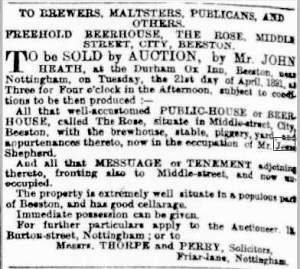 So it was that another hopeful arrived, by 1888, to try to succeed at The Rose. Jesse Shepherd was born in Stapleford in about 1852 and had previously worked as a stationary engine driver. In May 1870, he had married
a young local girl, Caroline Eyre, at Stapleford but, tragically, she had died during the following month. In 1872, he then married Emily Hazeldine (b c.1853, Bramcote, Notts) and they were to have two children. The
couple continued to run The Rose until 1891 after which they moved to live on Wollaton Road, Beeston and Jesse found work as a pit bank contractor, likely at Wollaton colliery. By 1911, they had moved to Radford with
Jessie working as a colliery banksman. Jessie died in December 1916 in Nottingham followed, almost exactly ten years later, by Emily.
So it was that another hopeful arrived, by 1888, to try to succeed at The Rose. Jesse Shepherd was born in Stapleford in about 1852 and had previously worked as a stationary engine driver. In May 1870, he had married
a young local girl, Caroline Eyre, at Stapleford but, tragically, she had died during the following month. In 1872, he then married Emily Hazeldine (b c.1853, Bramcote, Notts) and they were to have two children. The
couple continued to run The Rose until 1891 after which they moved to live on Wollaton Road, Beeston and Jesse found work as a pit bank contractor, likely at Wollaton colliery. By 1911, they had moved to Radford with
Jessie working as a colliery banksman. Jessie died in December 1916 in Nottingham followed, almost exactly ten years later, by Emily.
By now, it seems, it was apparent that The Rose was not the success that its owners would have been looking for so, perhaps inevitably they, wanting to move on, put it up for sale by auction (see right). At the sale, it was
apparently purchased by the Nottingham brewers, Shipstones who were, perhaps more than any other, in a position to turn things around.
An early tenant - certainly by 1901, possibly before - was Frederick Charles Smith who was born in Armitage, Staffordshire in 1864 but, by 1891, he was living in Wilford, Notts, working as a grocer while his father
was working as a coal miner. In 1899 he had married Harriett Newcombe (b. 1856, Shelford, Notts). Sadly, in 1904, Harriett died and which, perhaps understandably, Frederick left The Rose, took a new home on Station Road
and then worked as a coachman. Later he took a job as a Council labourer, never remarried and continued to live in Beeston up to his death in 1940, aged 75.
If so far, Shipstones had been unfortunate with its tenants at The Rose, the next - but , ironically, the last - was to perhaps make up for it as John Joseph Bywater was in many ways perfect for the job and really got
things going!
Born in Beeston in 1868, the son of Edward & Emma (née Jowett) Bywater, he was part of a well-established Beeston family. In 1891 he had married Harriett Butler and they had two children before Harriett's early death,
aged 28, in 1898. In May 1903, he married Eveline Bianchi Green (née Booth) who had been widowed in 1901, aged 30, with one daughter.
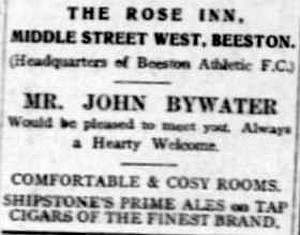 Although John had previously worked in engineering, he and his new bride decided to change direction and to take on the tenancy of The Rose, a new venture for each of them but one they took on enthusiastically, probably
in 1904. Certainly, the fact that John and his family were well known and popular within the section of the local population that were potentially their customers appears to have been the key and it was stirred by an
attractive advertising drive - see right - as well as the encouragement of amateur sports groups, such as Beeston Athletic Football Club, to meet there.
Although John had previously worked in engineering, he and his new bride decided to change direction and to take on the tenancy of The Rose, a new venture for each of them but one they took on enthusiastically, probably
in 1904. Certainly, the fact that John and his family were well known and popular within the section of the local population that were potentially their customers appears to have been the key and it was stirred by an
attractive advertising drive - see right - as well as the encouragement of amateur sports groups, such as Beeston Athletic Football Club, to meet there.
In 1910, and again in 1913, he was an 'Independant Labour' candidate for Beeston Council and was elected with the third highest votes on the latter occasion.
Although his time at The Rose had been a success for him as well its owners and its customers - and by 1915 he was to recall "10 years mine host", by then a problem had developed that was to see the end of his tenancy
and, indeed, The Rose itself.
The 1904 Licensing Act - driven by a an active temperence movement and a belief that the number of pubs in the country was beyond the number
needed to serve the needs of of the public and that their number should therefore be reduced. In Beeston, where there were then about 16 pubs, virtually the same number that had been there for the previous fifty years. But with
a population of about 9000 in 1904, each pub was serving about 560 of the population which compared with about 200 fifty years earlier. So, to some extent the problem was being solved by an increasing population, coupled with
a restriction on opening new licenced premises - as had been seen by the refusal of the 'Rising Sun' licence. But, perhaps with the need of a little fine tuning, the focus turned on The Rose which, as one of three pubs now
trading on that end of Market Street - standing in a close-knit group with the White Lion and The Star, then a newly renovated Shipstones pub. Perhaps inevitably in the circumstances, a renewal of its licence was refused in
July 1914, it closed and was converted to living accommodation. Later it was demolished when the site was redeveloped.
For his part, John Bywater, took over as the landlord at the adjacent Star Inn in June 1915 but, sadly, he died while working there in October 1919. In the following year, his widow married Isaac Bullivant, a widower, then
working as a cordwainer (shoe maker) at Chilwell Ordnance Depot. They were to live out their lives in Nottingham, where Eveline died in 1932.
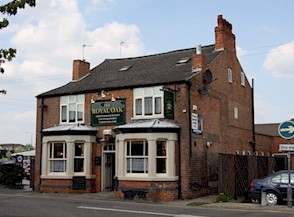 The Royal Oak - this small "local" pub (shown in the years up to its demolition in 2023) was to be found on Villa Street, Beeston -
hardly a "street" at all these days having been sliced up by large-scale modern day developments - but once situated in the heart of the lace
making area of Beeston.
The Royal Oak - this small "local" pub (shown in the years up to its demolition in 2023) was to be found on Villa Street, Beeston -
hardly a "street" at all these days having been sliced up by large-scale modern day developments - but once situated in the heart of the lace
making area of Beeston.
The pub was founded around 1853 by Emma Burnham, the widow of John Burnham who had operated as a joiner, based on Villa Street. Johnís whole estate had been
left to her for life, after which it was to be passed equally to their six children.1 The "Oak" would be part of this progression and, although
subsequent generations were to continue their joinery business - through to comparatively recent times - the Royal Oak was to play a major part in the
prosperity of the wider family.
See the story and genealogy of the Burnham and associated families.
It seems that the Burnhams saw the potential of the changing face of Villa Street in the middle of the 19th century - which has been well described by
Ernest Pollard in his account of his Pollard family lace business. Although the framework
knitters in the area would have suffered badly from the general downturn in the hosiery trade in the years up to the middle of the century - a decline which
was to continue relentlessly until it was eventually superseded by machine knitting - the parallel growth of a lace making industry in Beeston - with
Thomas Elliott's mill the centre in Villa Street itself - was, by 1850, after a couple of depressed decades, providing replacement jobs a-plenty.
.
To further this change, William Felkin, an entrepreneur of huge stature in the industry, had opened a lace factory at the top of the street in 1848 and -
using steam power, probably for the first time in Beeston - was operating over 90 plain net lace machines with the help of his two oldest sons, William
and Robert.
They probably decided by instinct but, if - as one would do now - the Burnhams had carried out a market survey, it would have soon confirmed that it was a
good location for their new venture. At the time it was being contemplated - the middle of the nineteenth century, the area bustled with activity in the
factories and numerous smaller workshops and there was crowded terraced housing on Cross Street, on Villa Street itself, on Albion Street and through onto
the bottom end of Butchers Lane (Wollaton Road) - all a stone's throw from the High Road. In 1851, Villa Street alone was home to over 10% of the population
of the village - and this rose to 22.5% when the surrounding streets were included. But it went much further than that! For the fastest growing sector of
the economy - lace making - the statistics show that almost 30% of those employed in the trade lived in the Villa Street area - half of those in Villa Street
itself.2 Taken together, it would have been very clear that there was plenty going on and, in turn, plenty of demand for another ale-house - to join the old
Commercial Inn which had operated on Butcher Lane since before 1841.
Although Emma Burnham was the earliest recorded licensee, by 1861 she had retired to live on Chapel Street, Beeston and her eldest son Edward had taken over as the publican - presumably
anticipating his share of his fatherís estate. Edward, born in 1816, like many within the family, was a joiner by trade and, for a time, continued to
describe himself as that in addition to his role as publican. It was he who managed the Royal Oak through a period of over twenty years when its reputation
in the neighbourhood was being established and when the lace trade was gathering apace all around. He appears to have been a decisive man - such that when
his first wife died he in 1845, he had remarried within three months - and an innovative businessman - diversifying into farming by 1871, whilst retaining
the Oak. It is likely that he retained these secondary sources of income as a response to the challenging changes that did occur locally - growth in the
lace trade was not always in a straight and rising direction. During Edwardís time in charge, the Felkin operation failed financially (in 1864) and it wasnít
until 10 years later that Frank Wilkinson arrived in the village to take over the derelict factory - where he was eventually to rebuilt and extend the business
to reach heights that far exceeded anything that went before. This period also saw the establishment of the Pollard family as major players amongst the
Beeston lace manufacturers - and right in the centre of the Royal Oaksís catchment area - although there was increased competition too, with the Cricketers
opening nearby, around 1870.
By about 1883, Edward was ready to retire - he was by than about 67 - and we would have expected him to look to his oldest son to take over but in this case, it
seems, this was not an option. Edward, junior had already established himself as the landlord of the Shoulder of Mutton in Hyson Green and its seems that chose
to turn the chance to return to Beeston. His second son, George was well established a joiner and was also, it seems, not interested and, rather then offer it
other sons, Edward turned to his son-in-law, Alfred Elliott, husband of his younger daughter Elizabeth, then in his mid-30s and, it seems with little licensed trade
experience - though born in Beeston, he had been working in Yorkshire as a printerís machinist.
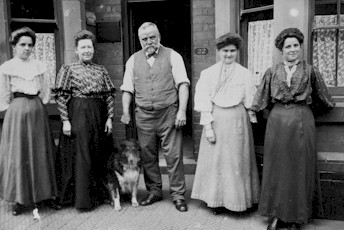 As it turned out, Elliott - seen left, standing at the entrance to the Royal Oak with his wife and two daughters3 - established himself well, was able to ride
the boom years of Wilkinsonís Anglo-Scotian mills - which continued and grew despite two major fires, until folding shortly after Wilkinsonís death in 1897 - and Pollardís
growing operations - which continued that growth well into the 20th century.
As it turned out, Elliott - seen left, standing at the entrance to the Royal Oak with his wife and two daughters3 - established himself well, was able to ride
the boom years of Wilkinsonís Anglo-Scotian mills - which continued and grew despite two major fires, until folding shortly after Wilkinsonís death in 1897 - and Pollardís
growing operations - which continued that growth well into the 20th century.
On one particularly memorable day in 1898, the victorious Nottingham Forest team paid an early visit to the Royal Oak after winning the FA Cup against Derby County at Crystal Palace.
Children for miles around had been invited for free lemonade to celebrate the win and the players had joined them for a drink after a training session in the fields below Beeston
Station4 - and had even brought along the Cup. As it was being packed away, the Club Secretary - Henry Hallam - turned to Lily Elliott, then only 15, who was helping behind the
bar, and offered her one of the red ribbons from the Cup, with the words, "Keep this - it might be something to remember in your old age." And 60 years later she did when she
recalled the incident - and proundly confirmed that she still had the ribbon - for a feature in the Nottingham newspapers when Forest had once again reached the final in 1959 - against
Luton who they beat 2-1.5
Alfred Elliott was to continue as a popular licensee of the Royal Oak, supported by his wife and daughters, until his death in 1912. Then, the license was continued by his widow
Elizabeth - certainly to 1920 and possibly until her death in 1933 - and then by their youngest son Harold Burnham Elliott. When Harold died at a young age in 1944, the Elliott
family had been licencees at the Royal Oak for over 60 years.
Meanwhile, Edward Burnham, lived out a retirement of about 18 years, no doubt offering an occasional word of advice but from a comparative distance - having moved away, first
to live with his daughter Mary's family on the then fashionable Queens road and then, in deteriorated health into lodgings on Dagmar Grove. He died in 1901 at the age of 85
leaving an estate valued at £6,597 - which would the equivalent of over half a million Pounds in todayís values.
Nowadays, the pub sits fairly incongruously at the edge of Sainsburyís car park. Villa Street itself - or what is left of it - gives little indication of how it must
have appeared in its hey-day. Swiss Mills, the villa housing that once housed the owners and managers and the various small workshops have gone, the Anglo-Scotian across
what remains of Albion Street is now converted for stylish apartments and modern office units now replace the terraced housing on Cross Street and Wollaton Road. Much of
this change is inevitable and welcomed - but the hotchpotch of the streets that remain is a poor memory of a key part of Beestonís past. But the Royal Oak, still an
attraction for real ale enthusiasts, music nights - and, of course, its loyal regulars. Itís a survivor - and a reminder, for those who remember, of a different
age.
1 John Burnhamís will dated 15 September 1853, left everything to his "dear wife Emma Burnham" for life, then equally between their
six children It was valued at under £300 (equivalent to about £21,500 in todayís values). He died nine days after making the will, on 24 September 1853.
2 These statistics have been derived from a transcription of the 1851 Census which is part of authorís Beeston database. The methods used and overall Beeston
statistics can be seen at by clicking here
3This picture, probably dating from about 1910, shows Alfred and his wife Elizabeth (née Burnham). Next to Alfred, to the right, is their younger daughter Emma who never married.The
lady on the exteme right appears to be their eldest daughter Lily Ann who married later in life, aged 40.The lady on the left is possibly Sarah ((née Eaton) who married their eldest son
Alfred in 1909.
4This area, which was also used for cricket, had been the venue for an FA Cup first round match in the previous year, against Notts County; Forest had won 3-1.
5Details of the 1898 match, names of the team and a photograph can be found at http://www.fa-cupfinals.co.uk/1898.html. Henry Hallam, aged 32, can be found lodging at 40 Kirk
White Street, Nottingham on the 1901 census (Piece 3171/127). He was the son of Thomas (a farm labourer) and Elizabeth from Ruddington, Notts. It seems that Henry left home at a very young age - in 1881, age
13, he was a tap boy at the "Adjutant White" pub on Hungerhill Road in St Anns, Nottingham. By 1891 he was an overlooker in a hosiery warehouse and living in the same Kirk White Street lodgings.
The incident at the Royal Oak was recalled in an interview with Lily - then Mrs George James, aged 75 - in a currently unidentified Nottingham newspaper clipping featuring the run-up to the 1959 Final.
Click Here to Return to the Top of This Page
|
 |